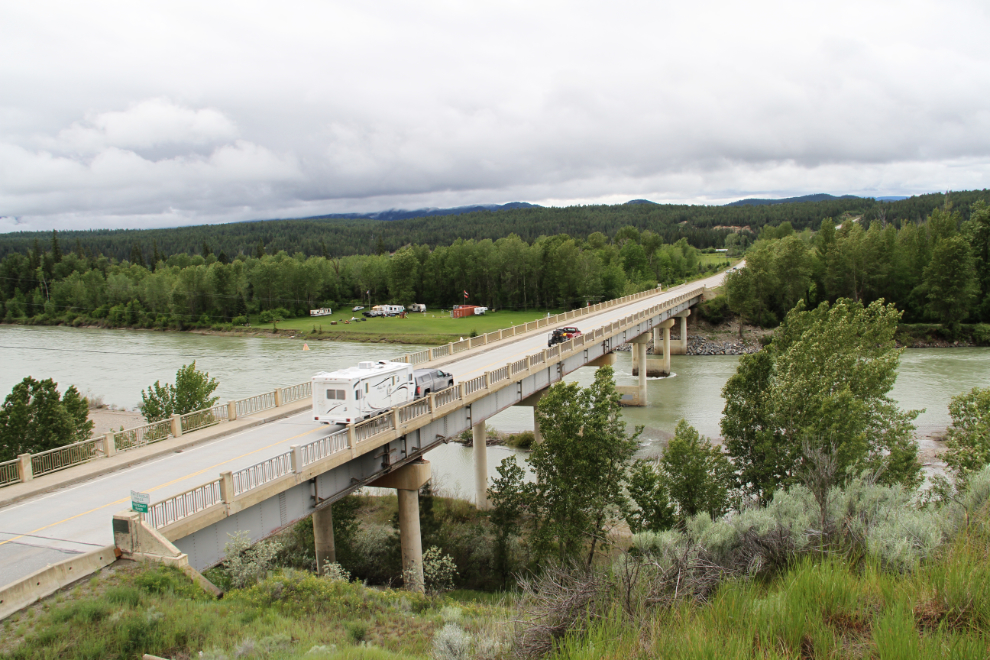Exploring Fort Steele Heritage Town, BC
The National Historic Site of Fort Steele Heritage Town was our main focus for Day 30 of the trip – Monday, May 23rd – and we only drove 123 km (76 mi) to Sparwood following that visit.
We spent over 4 very enjoyable hours at Fort Steele, and this is a very long post, with 51 photos.
We actually began our exploration of Fort Steele Sunday evening, by taking the 10-minute walk to the Fort Steele cemetery (during a brief break in the rain) from the Fort Steele Resort and RV Park where we camped. Cemeteries can often tell a lot about a community.

The only early headstones we found were those of members of the North West Mounted Police. In 1887, during construction of Kootenay Post, 4 members died of typhoid fever, and their deaths are all marked by this single headstone. They were Cst. Henry Owen Lasmby (died Sept. 22, 22 years old), Cst. James Mason (died Oct. 20, 24 years old), Cst. Abraham Warner Fisher (died Oct. 25, 27 years old), and Cst. Herbert Mitchell (died Dec. 16, 23 years old). A large red granite hadstone marks the death of Cpl. Duncan Roderick MacNair, who shot himself while delirious from fever at nearby Wardner, on April 27th, 1898 – he was 23 years old.
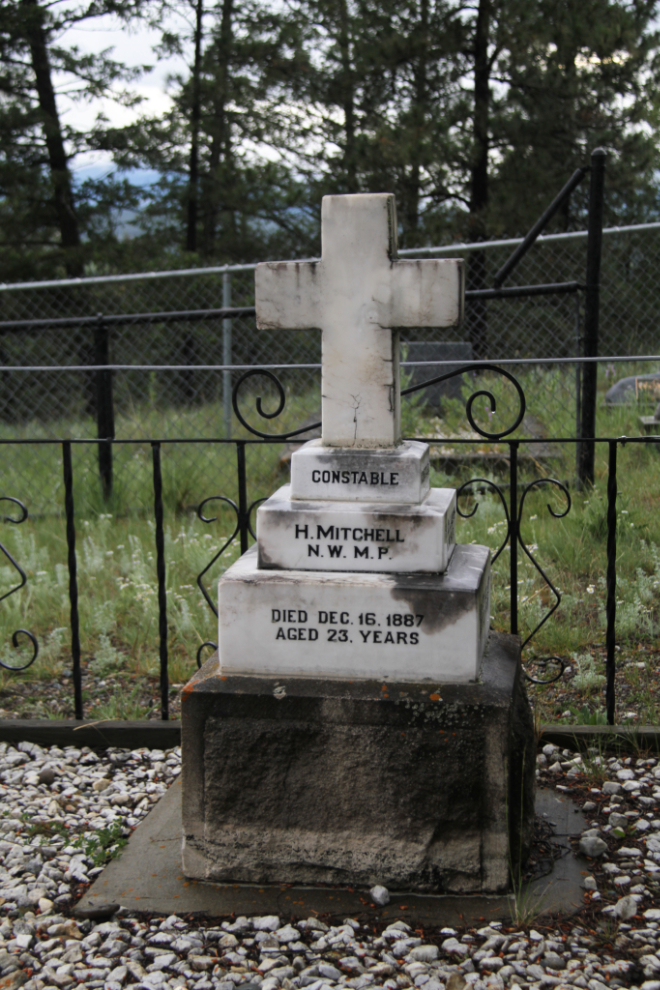
A few other early graves offered the potential for information, but we could see no markers.
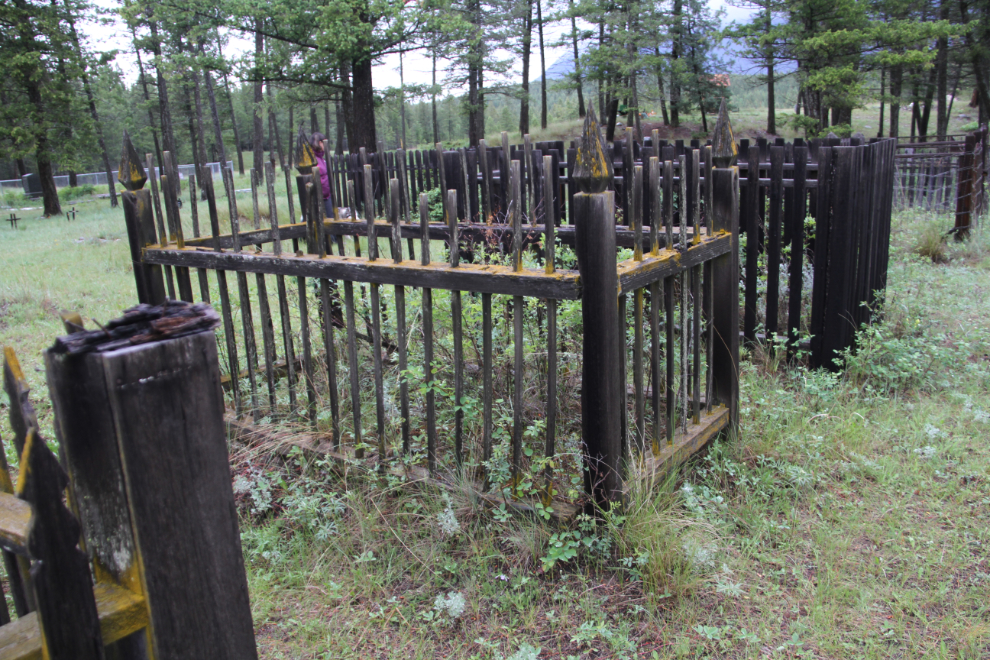
A very large number of graves are simply marked “Unknown”. My guess is that the records have been lost or destroyed, perhaps in a 1906 fire that destroyed much of Fort Steele’s remaining commercial district.

While our search for early information at the cemetery wasn’t very productive, the police memorials offer a glimpse at how hard life was, and some of the newer graves have wonderfully creative folk art as part of the memorial, a hint about some of the people who live in the area now.
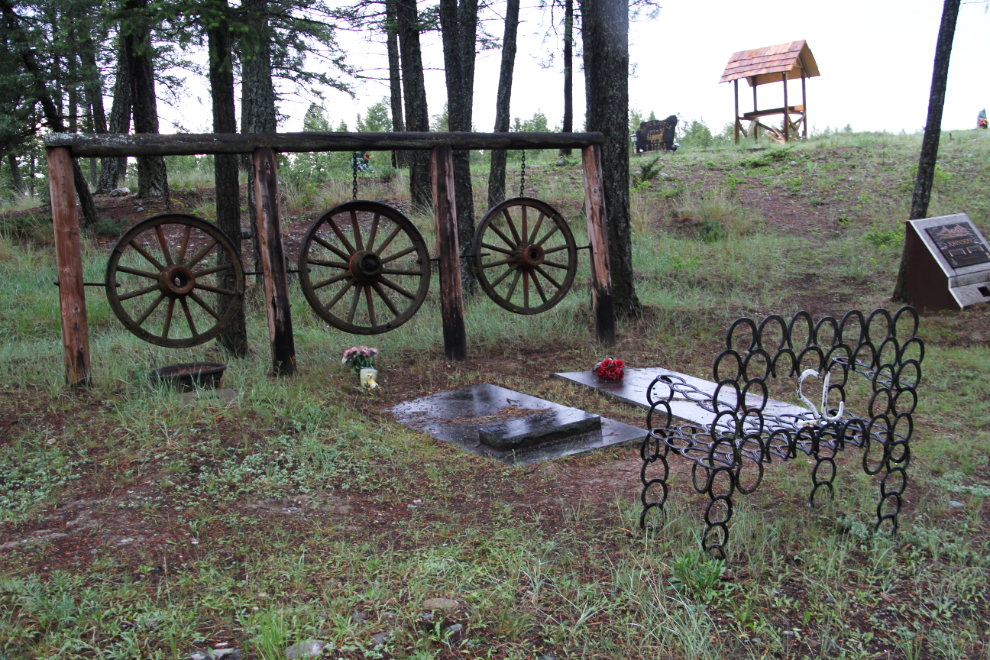
Cuddling with Dad while he writes is the favoured spot of the kids in the morning, but on Monday morning, Bella wanted the chair instead of being at my feet, and forced me off the seat! Well yes, of course I could have kicked one of them off, but they looked so sweet… 🙂
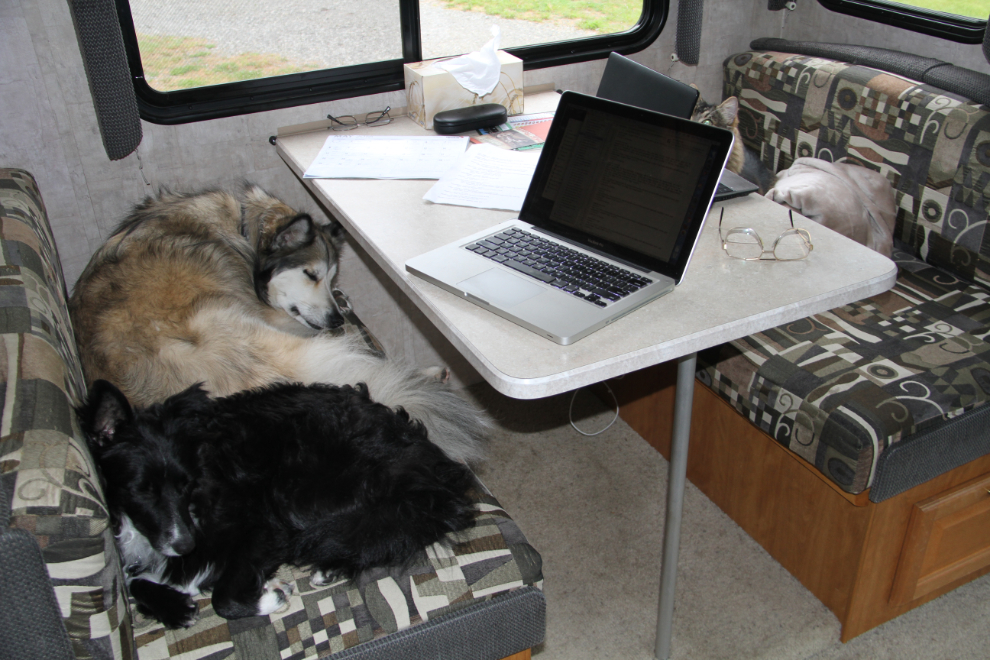
The continuing rain dampened our spirits a bit, but we had packed up and were at the historic site half an hour after its 09:00 opening. I had made a brief visit to the site in about 1970, and this was Cathy’s first visit.
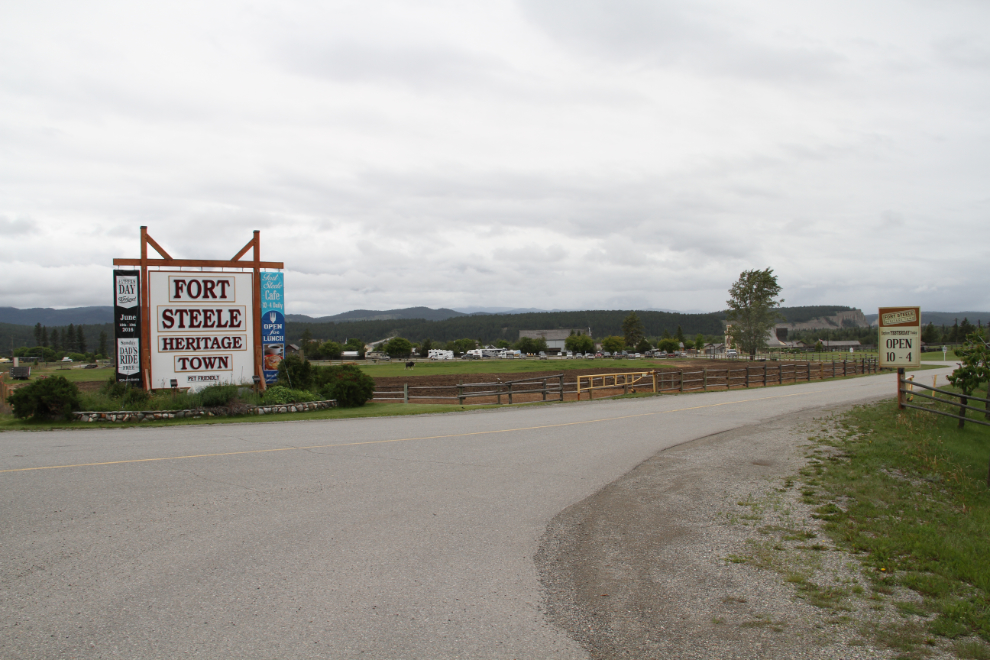
The railway part of the site, the first part you come to as you drive in off Highway 93/95, doesn’t open until the Father’s Day weekend – Saturday, June 18 this year – but it looked like they have some very interesting equipment, such as this underground coal-mining locomotive, powered by compressed air, and some of the cars it pulled.
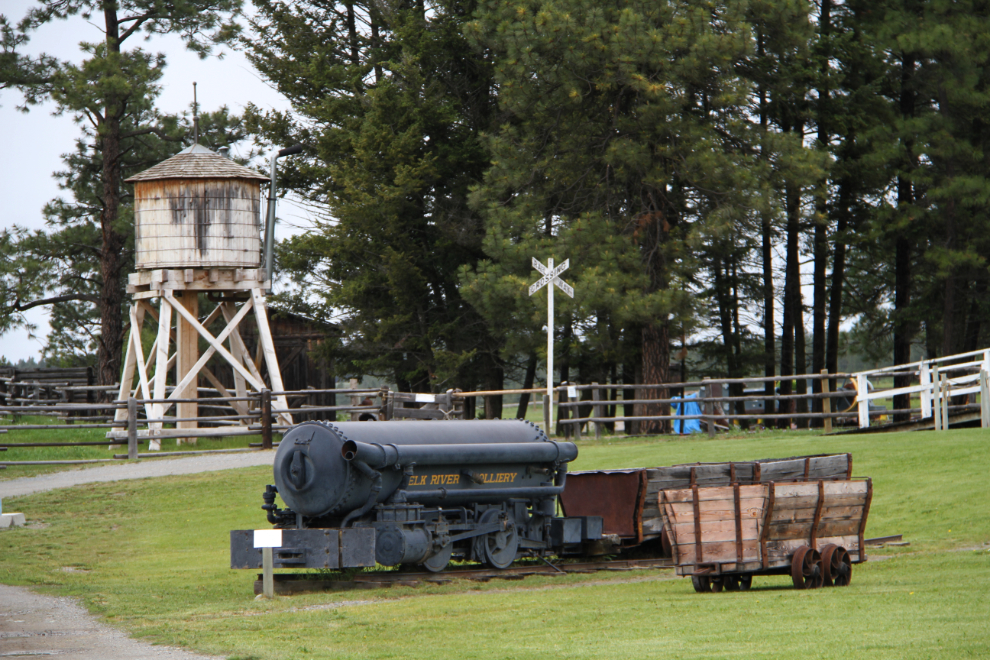
The entrance to the town is through a building modelled after the Fort Steele Brewery which once stood across the river in Westport.
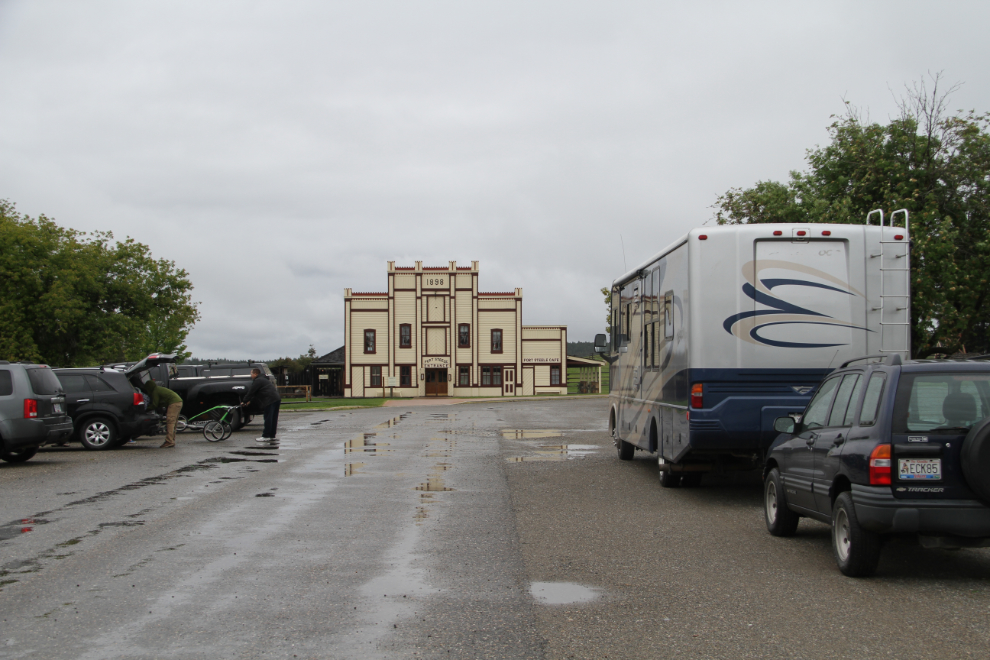
For $1, a copy of “The Boom and Bust of Fort Steele” was a great deal. I actually didn’t use it during our visit as interpretive signs (and interpreters) are plentiful, but it’s sure handy to put together this post.
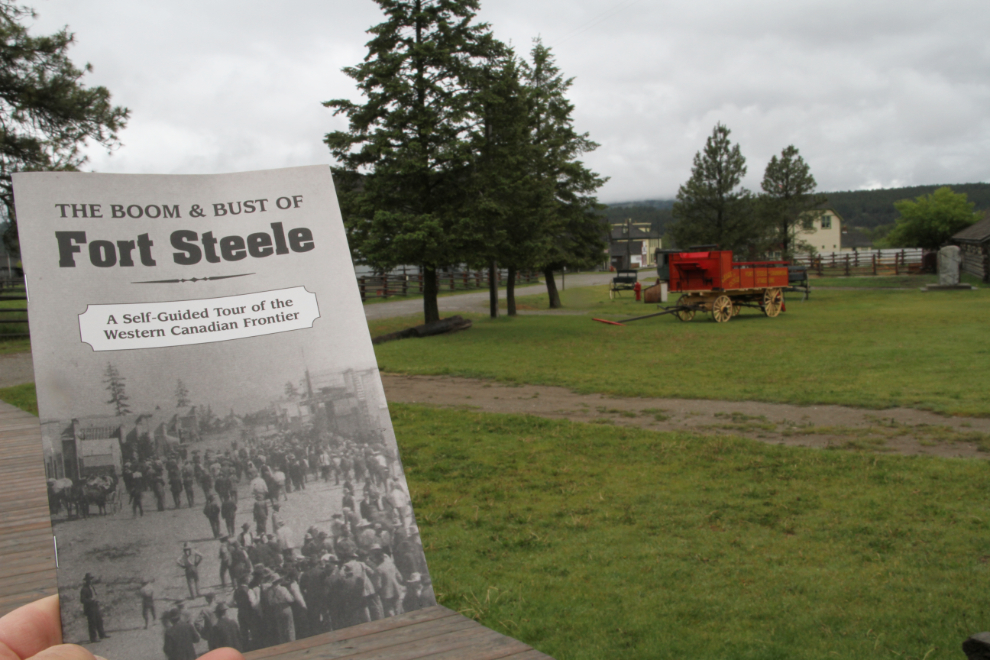
Kootenay Post was established by North West Mounted Police (NWMP) Superintendent Samuel B. “Sam” Steele in the summer of 1887 as the first North West Mounted Police post west of the Rockies. Steele and 75 men were sent to the area to resolve a dispute between the local Ktunaxa tribe and European settlers, and the fort was strategically located on a bluff overlooking the Kootenay River. It was, however, not on this site but on the opposite side of the highway – the Officers’ Quarters building was moved here in 1964, and the other are replicas.
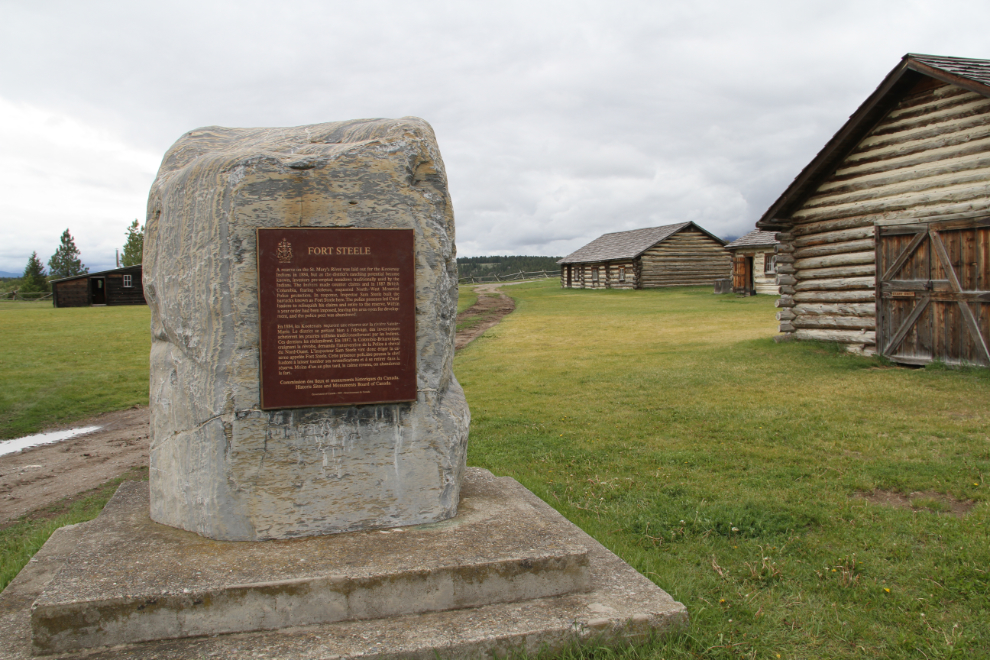
The “bastion” seen in this photo is a replica of a water tower that was built during Fort Steele’s heyday in 1897 – it held 17,000 gallons of water, but the replica is a viewing tower.

This is the Officers’ Quarters, the only building with the original logs.

This is what Sam Steele’s room would have looked like in 1887-88. The buildings were constructed of yellow pine – about 1,400 logs were cut and hauled – with saddle-notched corners, floored with common lumber, roofed with shakes, and chinked with mud and grass.
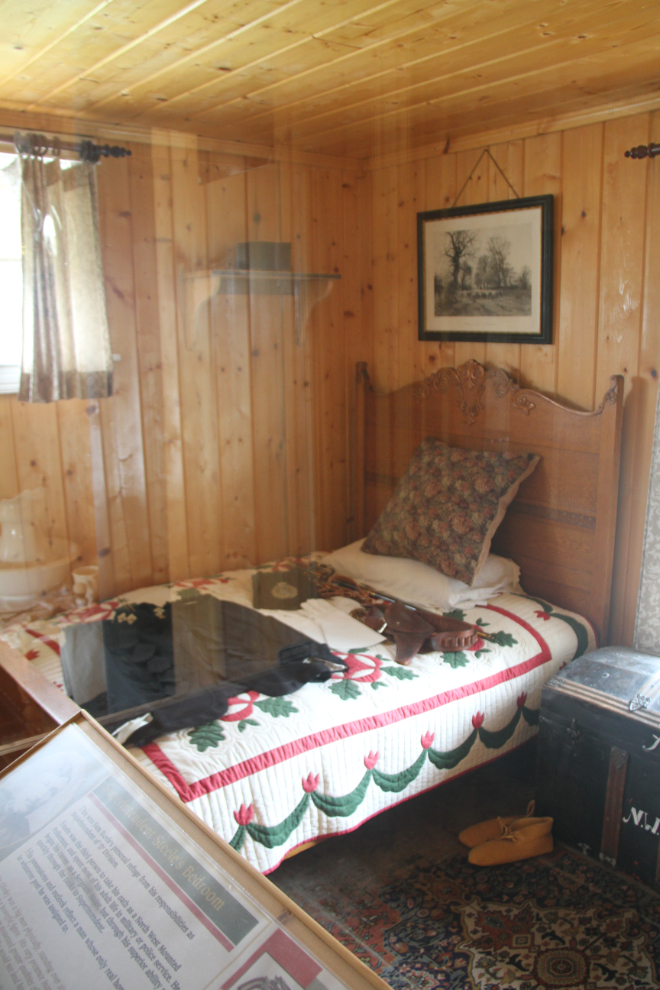
A school group had slept overnight on straw mattresses in the barracks, and it was fun to see them all in period costumes around the post.
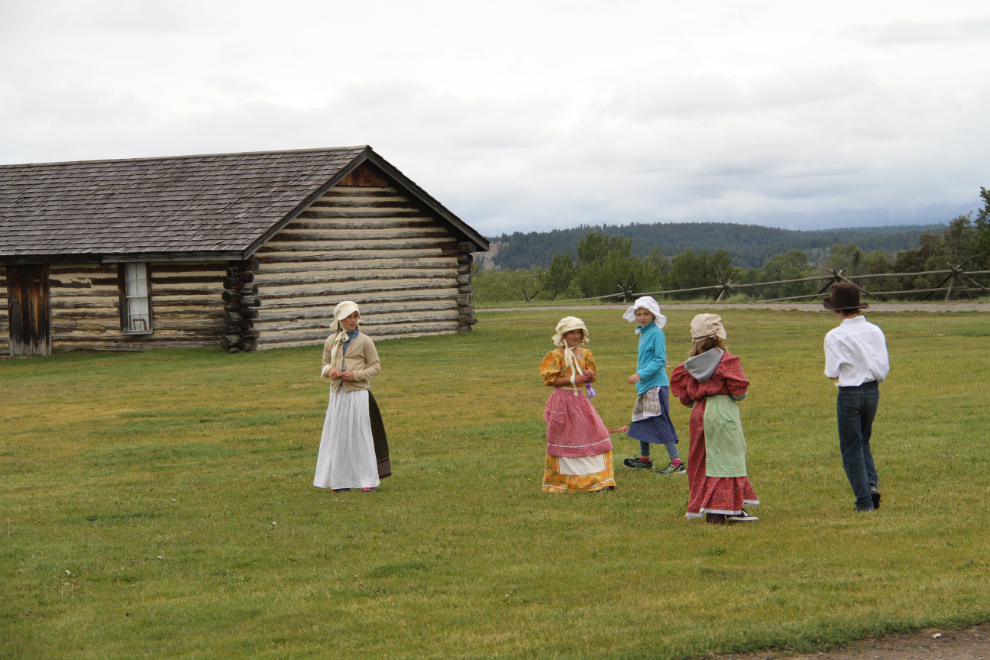
Climbing the water tower gives a good view of Kootenay Post…

… and some of the downtown area.
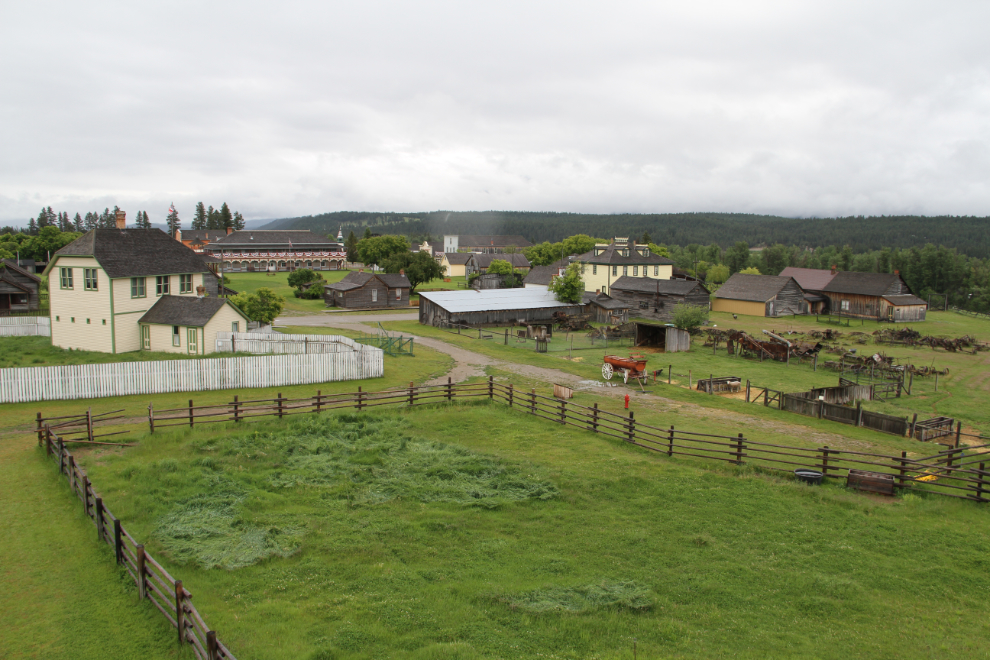
In 1970, several Clydesdale draft horses were transferred to Fort Steele from the Oakalla prison where they’d been used in a rehabilitation program. The horses and now one of the most popular attractions at Fort Steele – they’re used mostly for hauling visitors around the site in a wagon.

Geary & Doyle’s Livery Stable, dating to about 1900, was one of several at Fort Steele. There were originally corrals, a bunkhouse, and after 1907, George Geary’s house. Like many others, this stable was eventually converted into a garage for automobiles.

We spent some time talking to the leatherworker/interpreter at Jack Corrigan’s Harness Shop, and it was interesting to see some of the tools used. Everybody on site is an employee of the park – there used to be some contractors (such as the photo parlour), but everybody works directly for the park now.
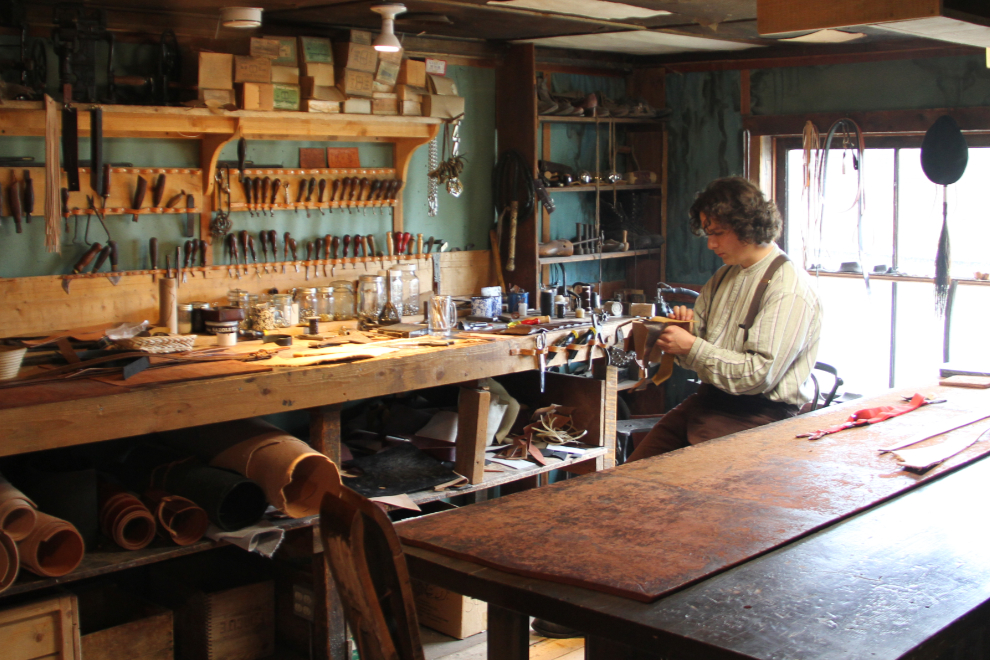
Many items are made at Fort Steele, from bread to knives and wool slippers, and sales of them help support the park.

Blacksmiths always intrigue me, and we spent some time watching and talking to the metal-artist at Bar & Comb’s Blacksmith Shop, one of several that were in the community.

A recent creation of the current blacksmith was this unique knife.
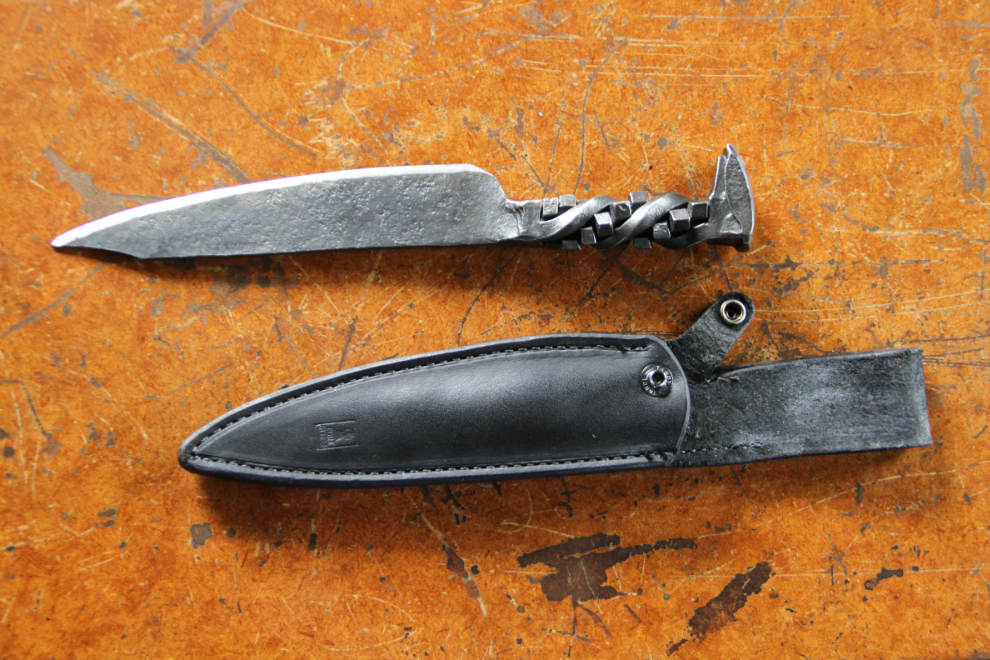
The 27-room Windsor Hotel was built as the Dalgardno Hotel over the winter of 1893-94, and was re-named the Windsor in 1899. It was one of 7 hotels during the boom years, and originally had a 40×60-foot annex which has been demolished.
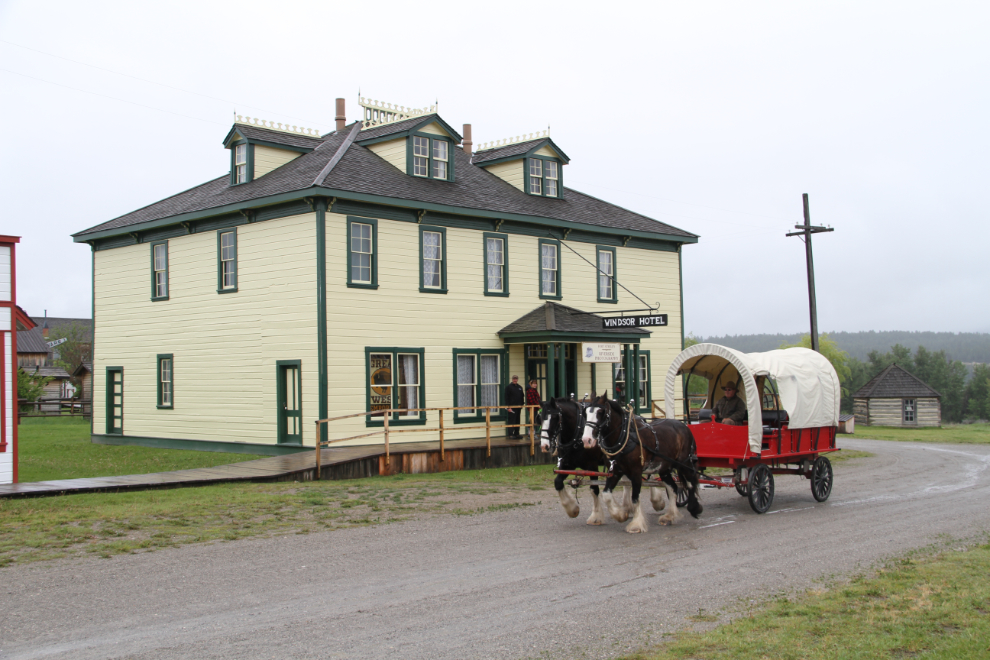
Baby slippers and wool from the town’s sheep.
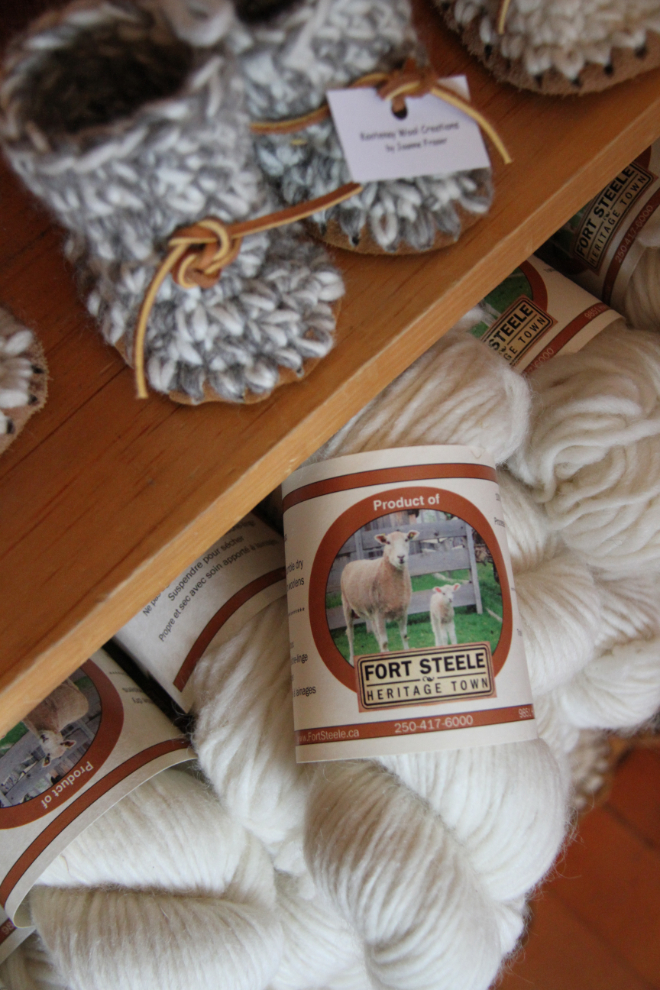
The Carlin & Durick General Store is packed with period items of every sort, as it would have been when it was in operation. In 1898, the town newspaper, The Prospector, said that it was “one of the most prominent and successful business enterprises in the interior of British Columbia”. One of the signs talks about their efforts to encourage “conspicuous consumption” of their goods.
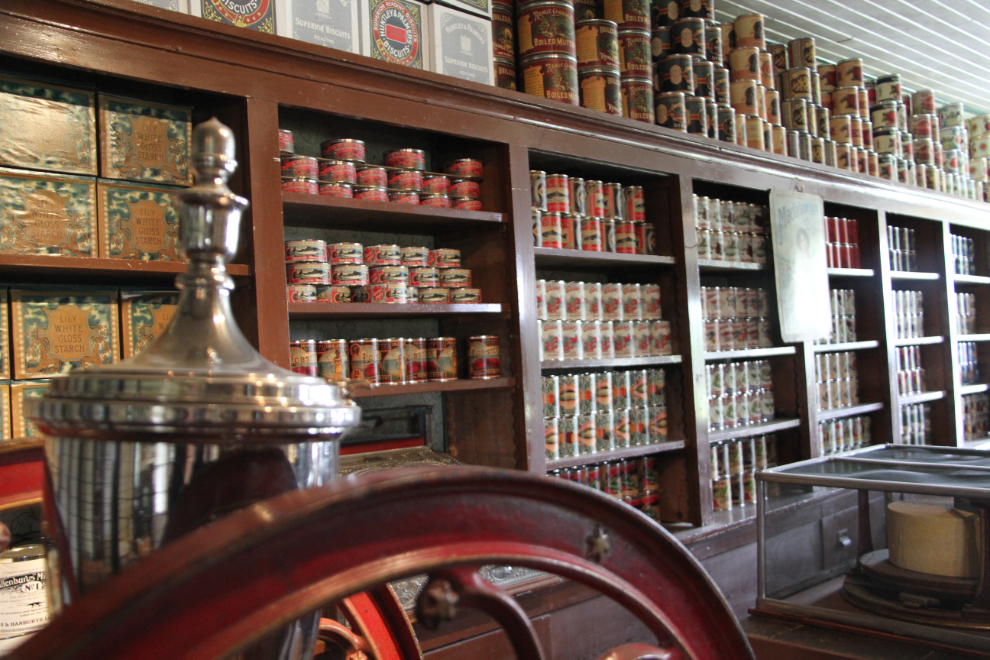
The variety of goods in the store can keep some visitors browsing the shelves for quite a while.
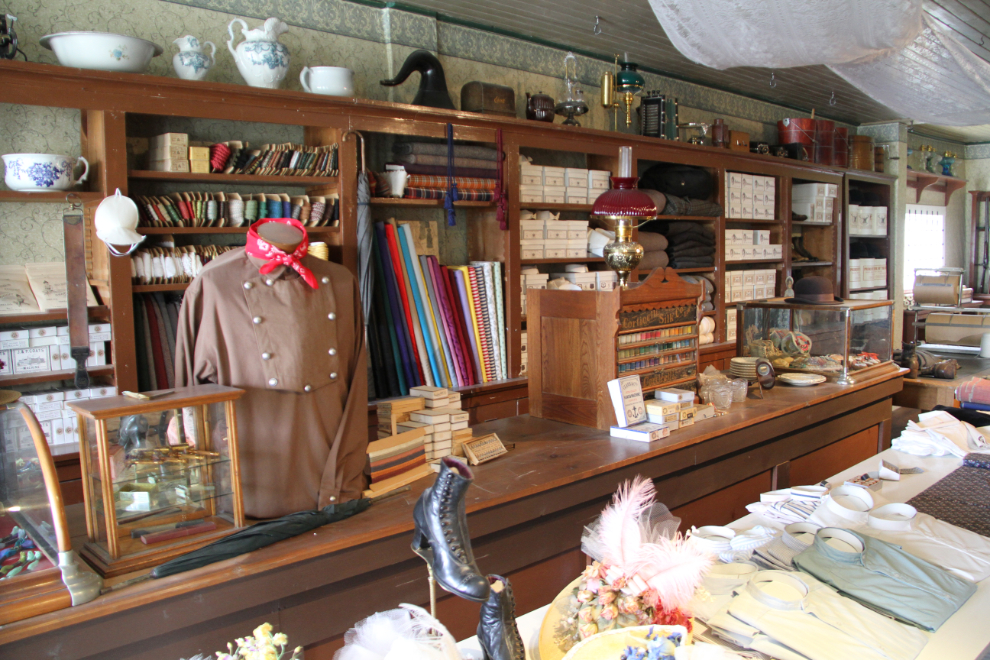
Some of the canned goods available at the store.

The Government Building was built in 1897 to house the courthouse and jail as well as the offices of the Gold Commissioner, Mining Recorder, Registrar, and the officials.
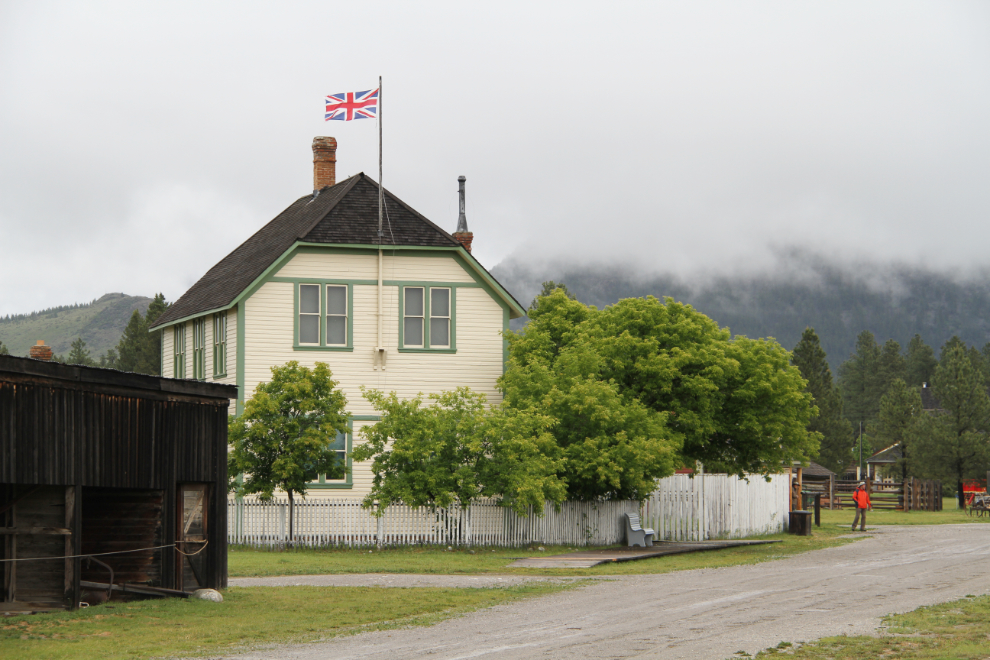
Going right back to Fort Steele’s beginning, John Galbraith built this little office/residence for his ferry operation across the Kootenay River in 1864, for people heading to the goldfields of Wild Horse Creek. The little community that grew up around it became known as Galbraith’s Ferry, and in 1888, it was renamed Fort Steele.
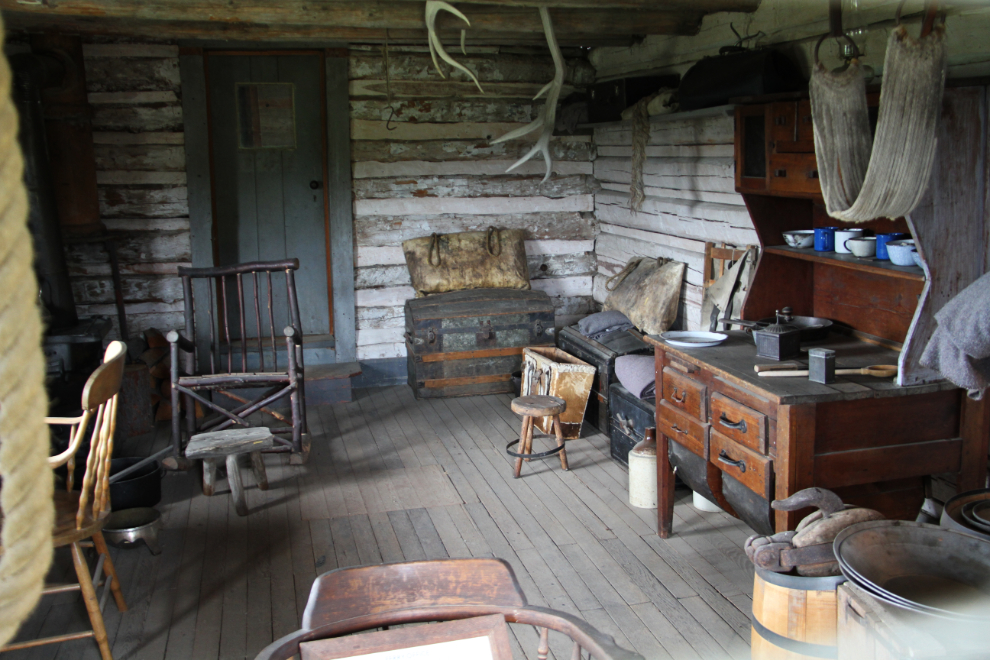
Early dentist’s offices had some similarities to torture chambers according to some reports 🙂 The machine on the left was a foot-powered drill. This “dental foot engine” was invented in 1871, apparently inspired by Singer’s sewing machines.
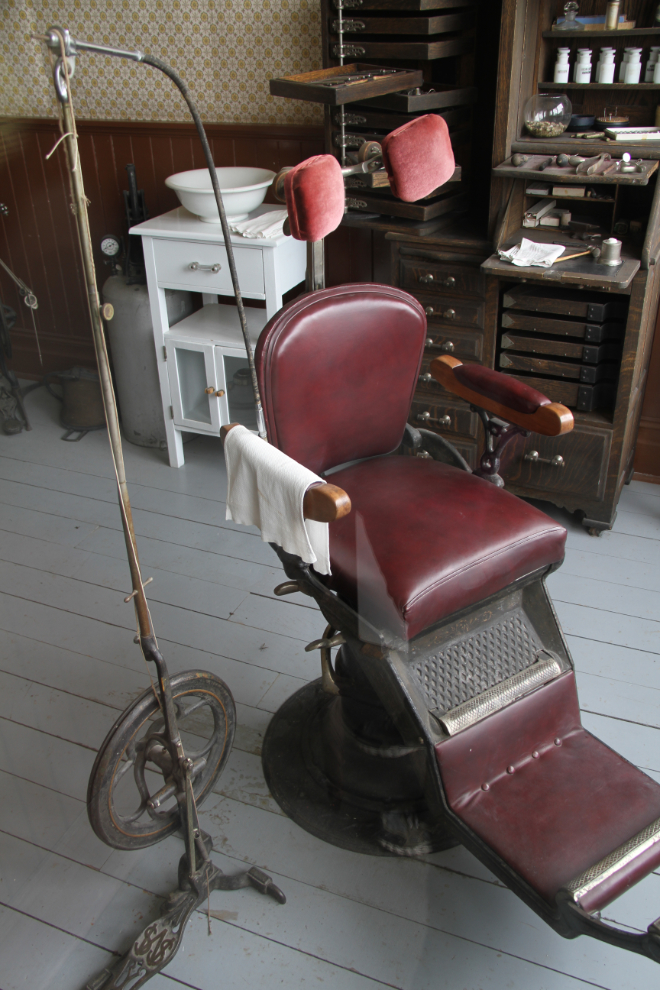
Show globes were used from the 17th Century until the 1950s to show that a store was a pharmacy. In the 1950s, the mortar and pestle took over their role.
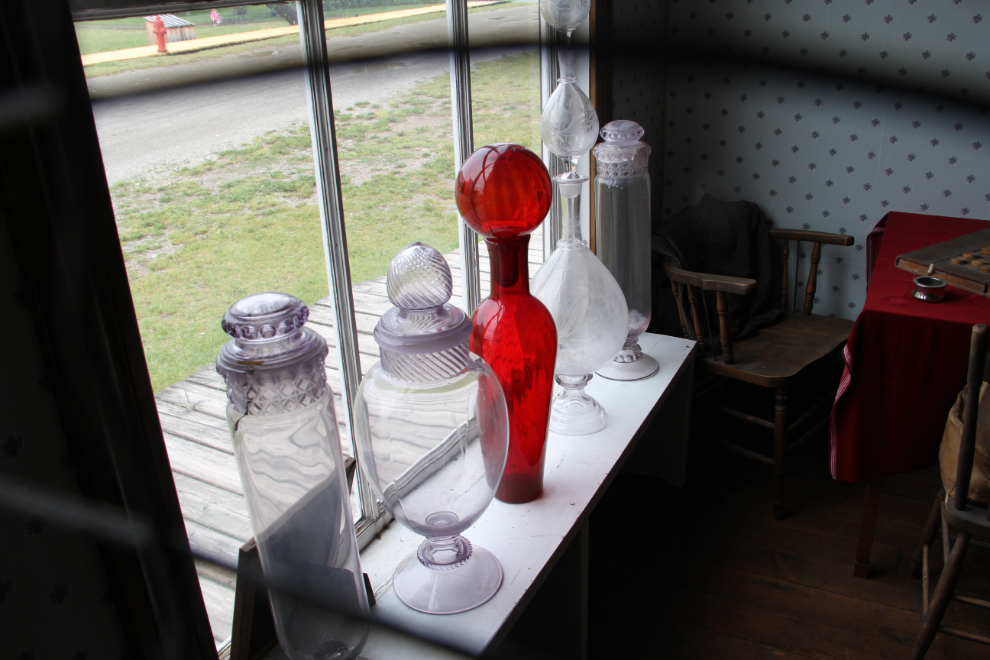
I love old printing presses, and the offices of The Prospector newspaper have some beauties. The newspaper was started by journalist A. B. Grace in 1895.

The City Bakery had been our goal for a mid-tour treat of coffee and a pastry. The original bakery was beyond restoration, and this is a reproduction.
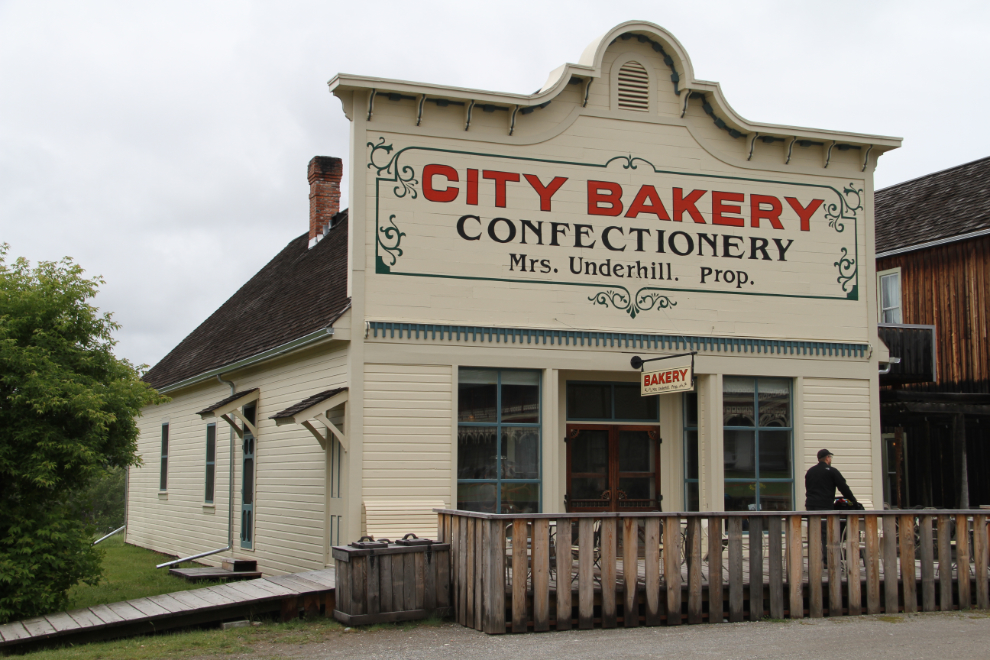
The cinnamon buns that came out of these ovens shortly before we arrived were delicious, and we also bought a loaf of sourdough wheat bread ($2.50 for a day-old one – it made fabulous grilled cheese sandwiches in the motorhome after the tour).

The schoolhouse doesn’t look very different than the 2-room, 8-grade one I went to starting in 1956, but it’s a whole new world from my grand-daughters’ high school whose Open House Cathy and I went to when we reached Airdrie. Over 70 students were crammed into this room at times, and the teacher, Miss Adelaide Bailey, made $70 per month. Built in 1898, this was the town’s second schoolhouse.
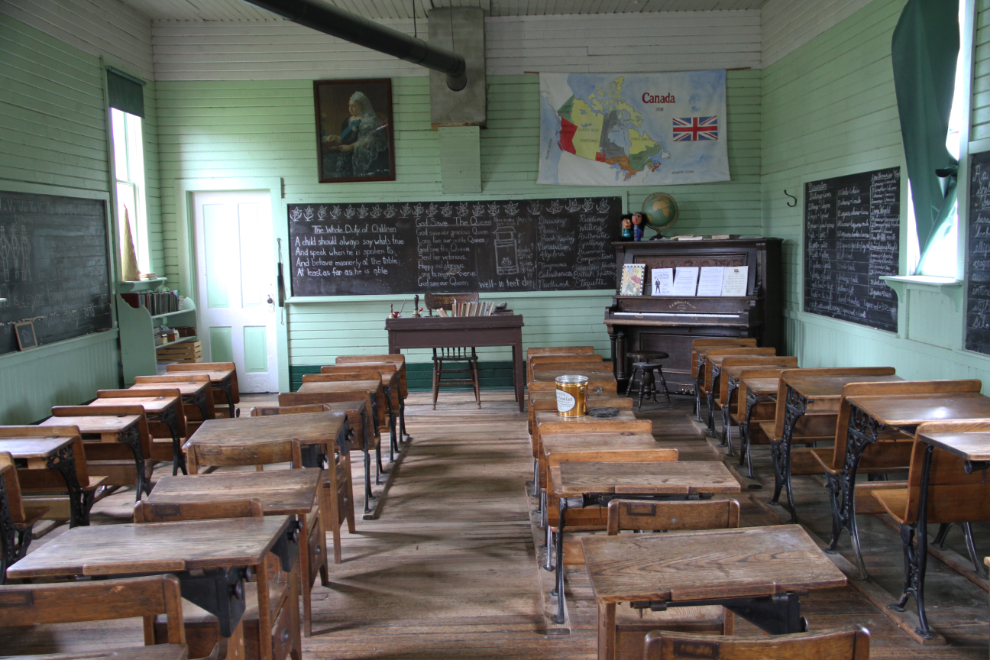
The McVittie House and land surveying office, built by Thomas Thane McVittie, is particularly interesting because much of the restoration work has done and/or paid for by volunteer surveyors, and the work is of a notably high quality. A very difficult series of moves brought the fragile buildings across the highway to the main townsite in 1994. The restored buildings were just opened in July 2015.
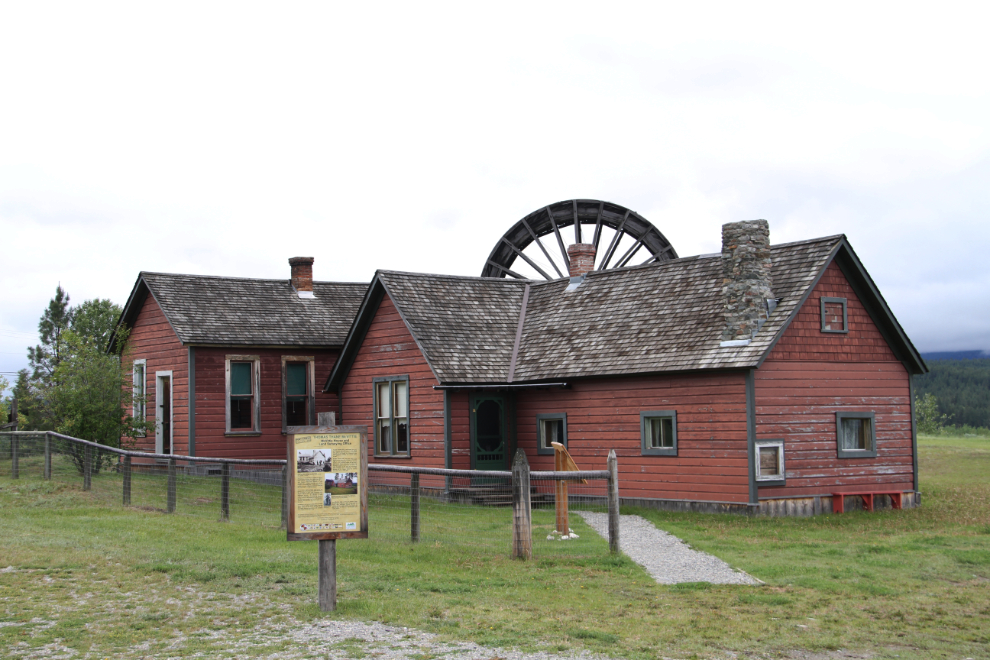
Mr. McVittie extensively rebuilt and enlarged his cabin in anticipation of his 1899 marriage, and the drawing room is a good indication of his status in the community.

McVittie’s office is well equipped with the tools of the trade, such as the pantograph on the table at left front. It was used to replicate maps and other drawings, and could even enlarge or reduce the original.
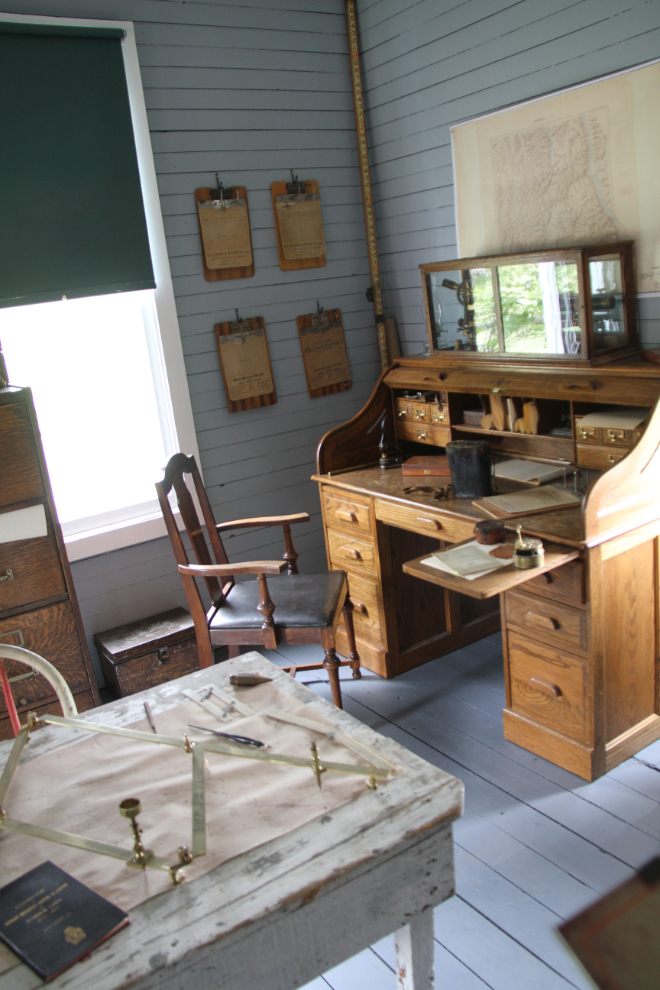
The Perry Creek water wheel was originally located about 25 miles west of Fort Steele, where it was used to pump water from mine tunnels up to 150 feet deep. Built in 1934, it is 32 feet in diameter, 7 feet wide, and could produce 68 horsepower to drive 2 pumps. The water pumped from the tunnels was used to wash the gold-bearing gravels brought up from. The wheel was successful, but the mine only operated for another 2 years.

A pair of Clydesdales take visitors past the assay office, schoolhouse, and St. Anthony’s Catholic church.
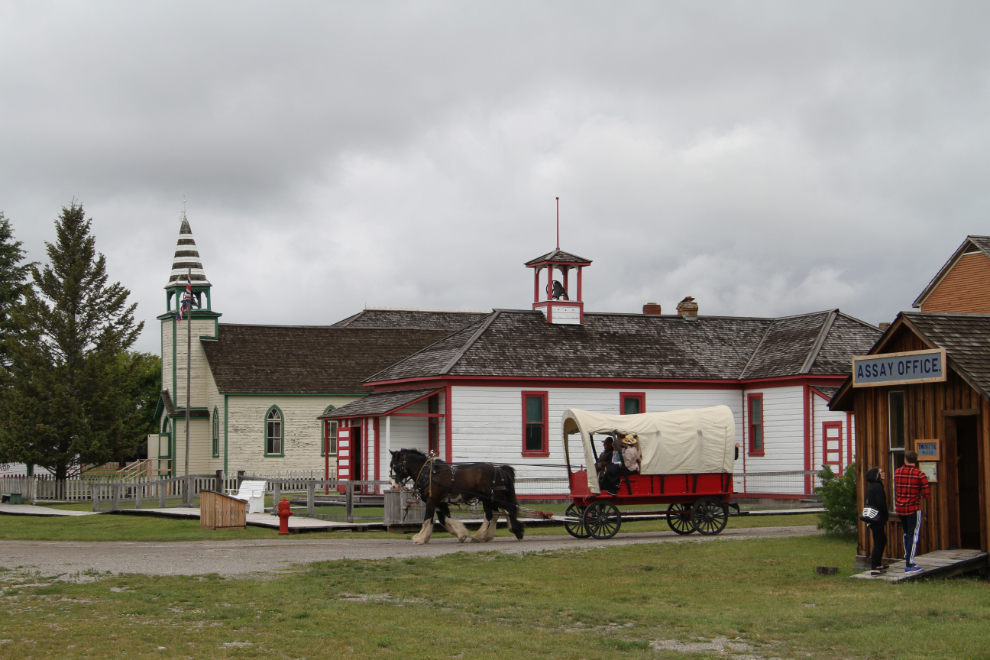
The Presbyterian church was built in 1898 – prior to that time, services were held in the schoolhouse or opera house.
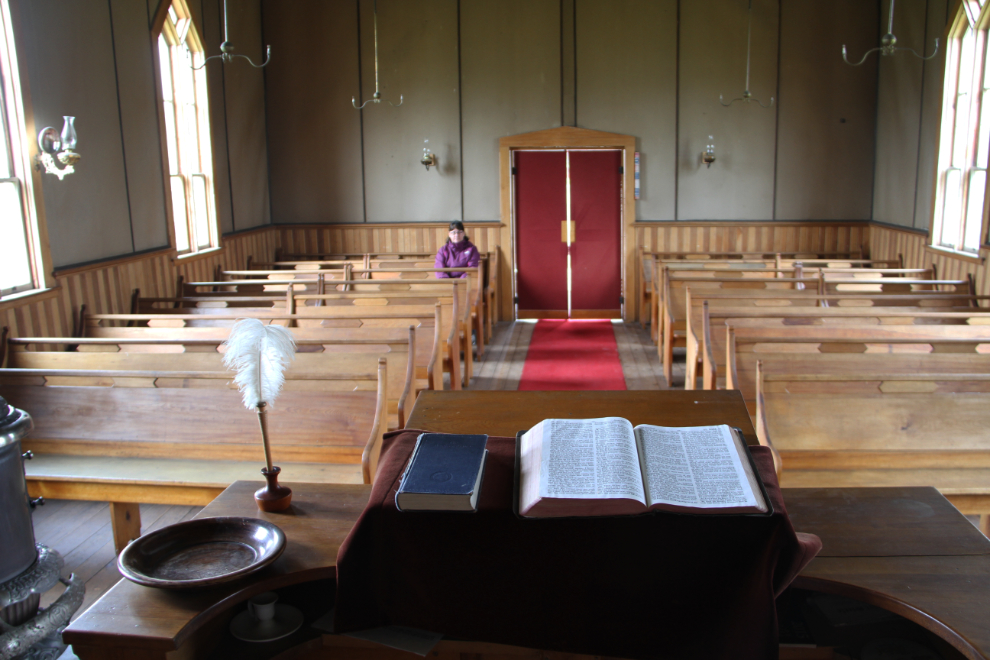
As well as sheep and the Clydesdales, there is other livestock such as this impressive turkey, who was strutting his stuff for a hen who was pretending to not be interested.
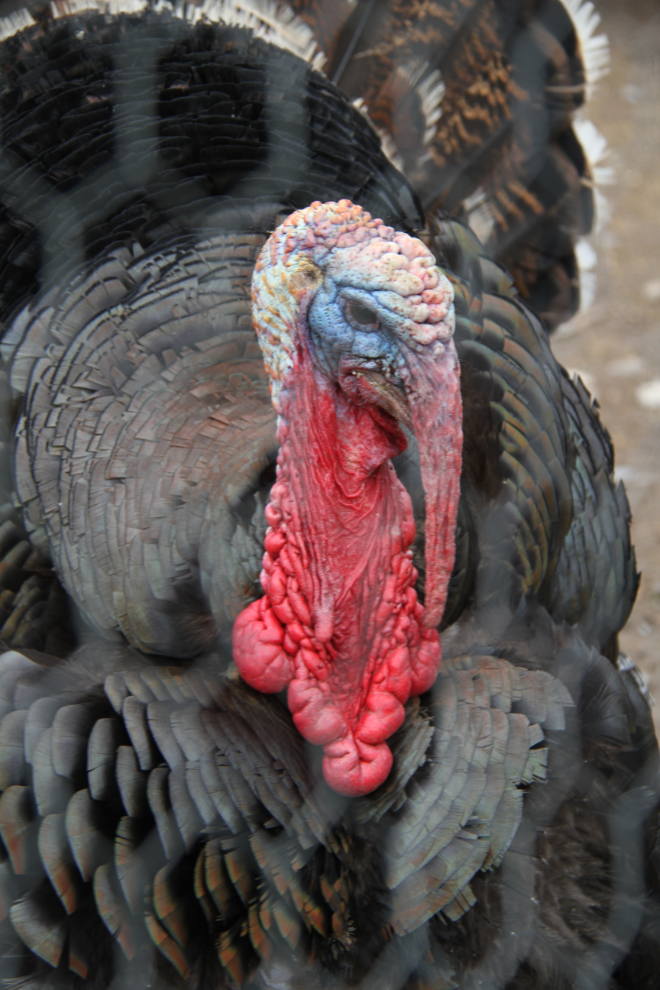
I didn’t know that Canada has a National Poultry Breed. This is the Chantecler chicken, created in Quebec in 1919 by monk M. Wilfred Chatelaine. Intended as a “dual-purpose” bird (good eggs and meat) that is resistant to cold, the breed was officially recognized in 1921.

The Opera House Coventry was built in 1897 – probably the most famous entertainer to perform here was Pauline Johnson. The upper floor of the building was used by the Freemasons, and the Kootenay Club, a fashionable men’s club.

While over 60 buildings have been restored at Fort Steele, a handful are beyond restoration and are being left to deteriorate, including Johnson’s Blacksmith Shop.
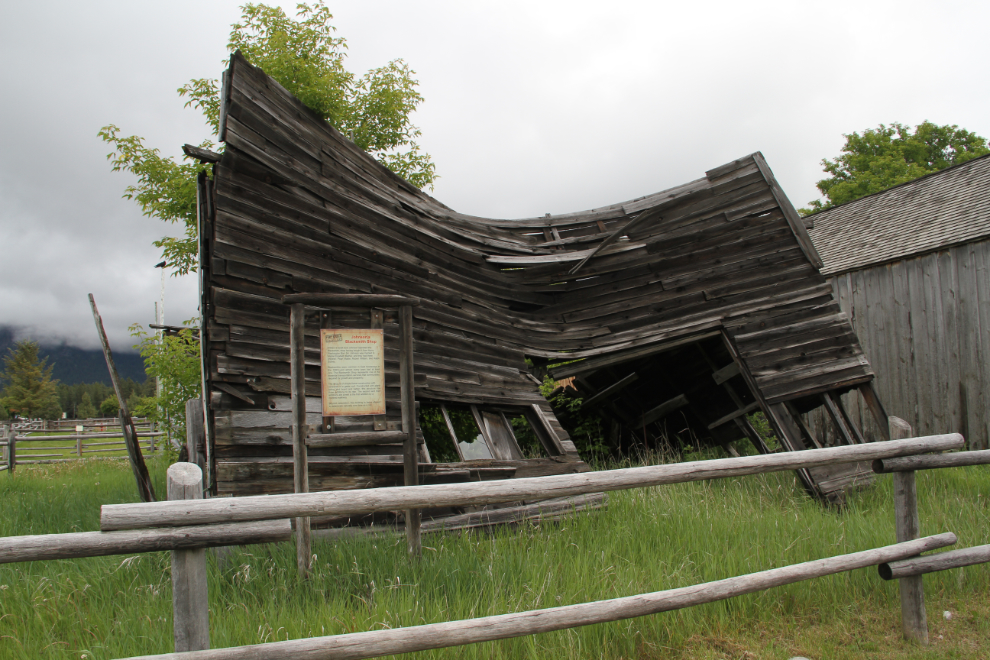
The lower floor of the reproduced Wasa Hotel is the main museum on the site. The upper floor apparently continues the story in more detail, but wasn’t open during our visit.
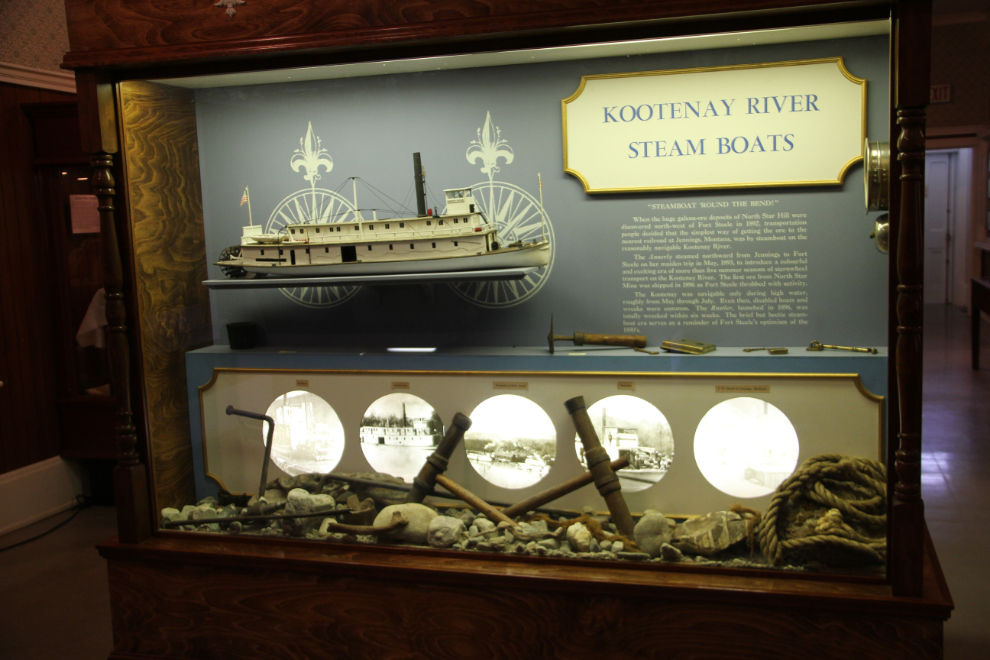
The vicarage for St. John the Divine Anglican church is a lovely little Victorian cottage that was built over the winter of 1898-99 after the arrival of the Reverend Charles A. Procunier.
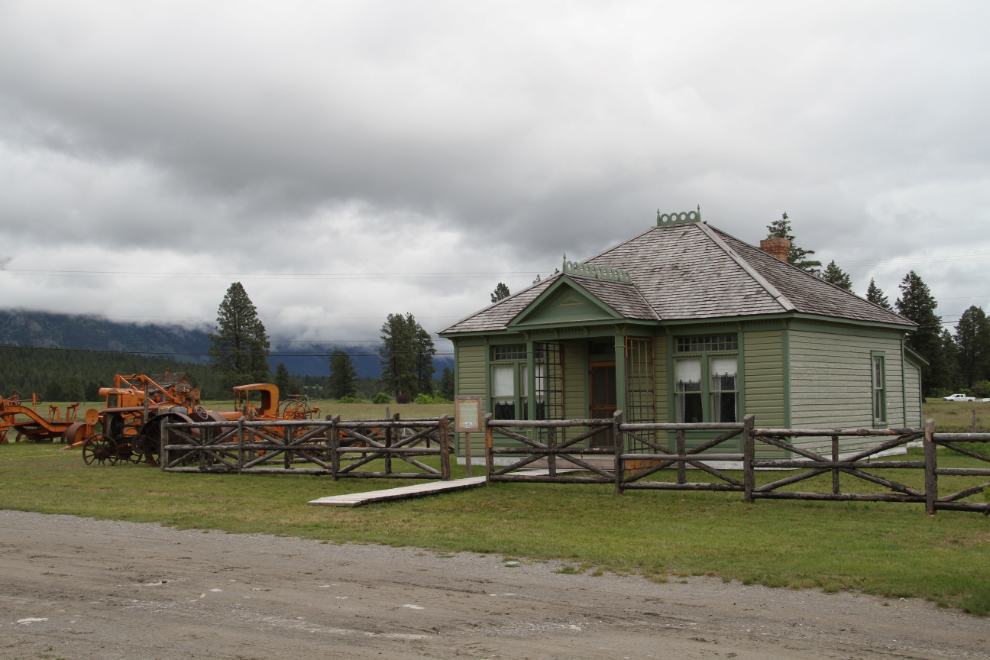
This Federal truck, among other trucks including REO, Fagel, White, Leyland, etc., was used to haul logs in the 1920s.

It’s believed that this beautifully-crafted log home was built on spec by Nils Hanson during the 1897-1900 building boom. In June 1897, the newspaper reported that 40 buildings were under construction, and that number could be tripled if enough lumber were available. Scandinavians were well known for their skill with log buildings, and the quality of the construction of this home contrasts sharply with other log buildings including those in the NWMP post.
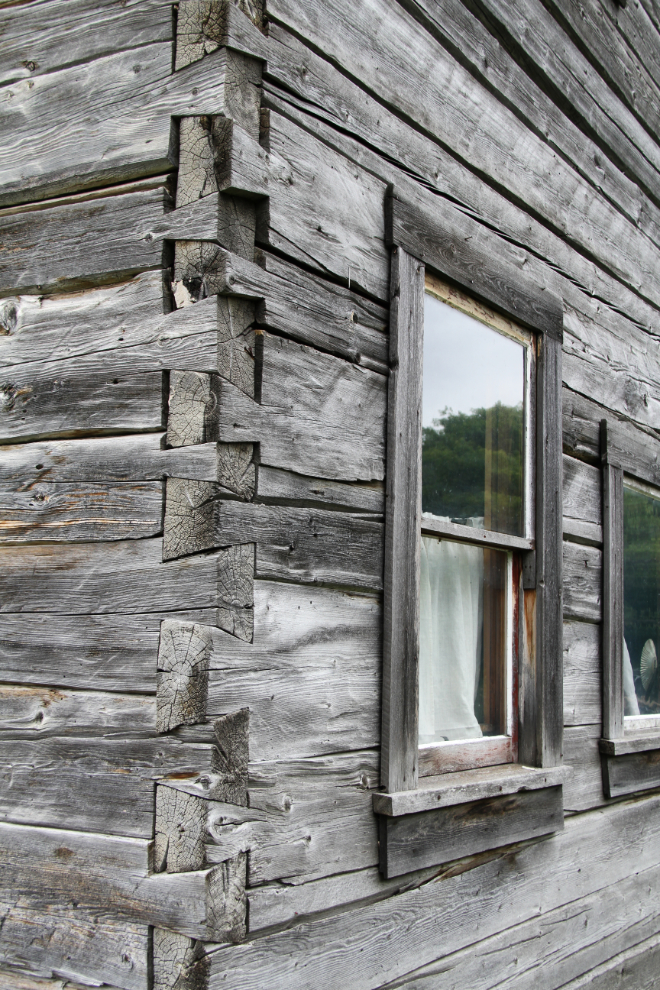
A look at Highway 93/95 crossing the Kootenay River, seen from the Fort Steele townsite. We finished our look at Fort Steele at about 3:00, and after a late lunch – grilled cheese sandwiches made from the sourdough wheat bread we bought at the Fort Steele Bakery – we crossed that bridge en route to Sparwood at about 4:00 pm.
